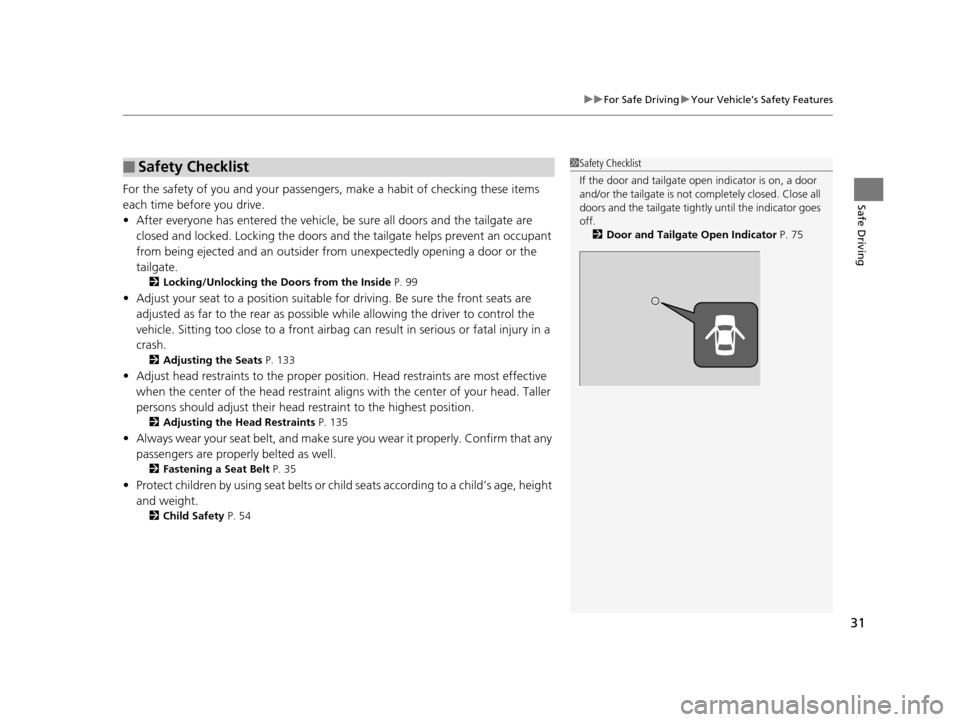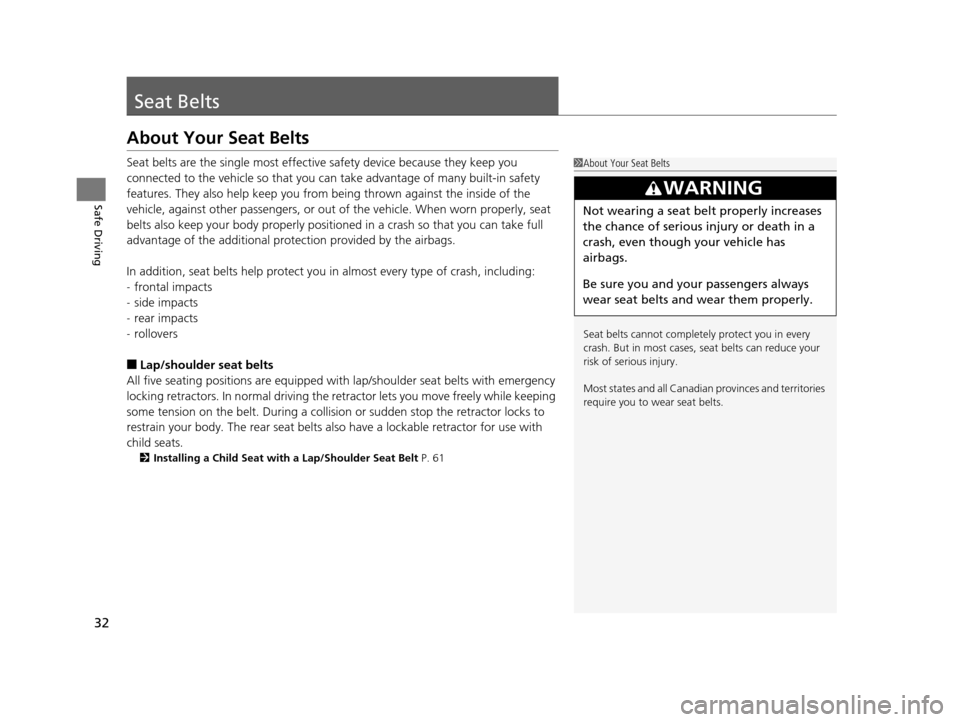2015 HONDA FIT child seat
[x] Cancel search: child seatPage 4 of 453

Contents
Child Safety P. 54Exhaust Gas Hazard P. 66Safety Labels P. 67
Opening and Closing the Tailgate P. 107 Security System P. 110
Opening and Closing the Moonroof* P. 115
Adjusting the Mirrors P. 131 Adjusting the Seats P. 133
Heating and Cooling System
* P. 154 Climate Control System* P. 157
Audio Error Messages P. 219General Information on the Audio System P. 223
When Driving P. 311 Braking P. 340Parking Your Vehicle P. 344
Refueling P. 347 Fuel Economy P. 350Accessories and Modifications P. 351
Maintenance Under the Hood P. 361 Replacing Light Bulbs P. 373
Checking and Maintaining Tires P. 384 Battery P. 393 Remote Transmitter Care P. 395
Cleaning P. 398
Engine Does Not Start P. 411 Jump Starting P. 414 Shift Lever Does Not Move P. 416
Emergency Towing P. 428 When You Cannot Open the Tailgate P. 429
Devices that Emit Radio Waves P. 435 Reporting Safety Defects P. 436
Authorized Manuals P. 441 Customer Service Information P. 442
Quick Reference GuideP. 4
Safe DrivingP. 27
Instrument PanelP. 69
ControlsP. 87
FeaturesP. 161
DrivingP. 301
MaintenanceP. 353
Handling the UnexpectedP. 403
InformationP. 431
IndexP. 445
15 US FIT-31T5A6000.book 3 ページ 2014年3月6日 木曜日 午後7時5分
Page 8 of 453

7
Quick Reference Guide
❙Grab Handle
❙Coat Hook (P150)
(Only on the rear left side)
❙Ceiling Light (P144)
❙Side Curtain Airbags (P50)
❙Rearview Mirror (P131)
❙Sun Visors
❙Vanity Mirrors
❙Map Lights (P145)
❙Moonroof Switch* (P115)
❙Cargo Floor Box (P148)
❙Cargo Area Cover* (P152)
❙Cargo Area Light (P145)
❙LATCH to Secure a Child Seat (P59)
❙Rear Seat (P140)
❙Side Airbags (P48)
❙Accessory Power Socket* (P149)
❙USB Port* (P163)
❙Front Seat (P133)
❙Seat Belts (P32)
❙Seat Belt (Installing a Child Seat) (P61)
❙Seat Belt to Secure a Child Seat (P62)
❙Seat Belt with Detachable Anchor
(P38)
* Not available on all models
15 US FIT-31T5A6000.book 7 ページ 2014年3月6日 木曜日 午後7時5分
Page 11 of 453

10
Quick Reference Guide
Safe Driving (P 27)
Airbags (P41)
● Your vehicle is fitted with ai rbags to help protect you and
your passengers during a moderate-to-severe collision.
Child Safety (P54)
● All children 12 and younger should be seated in the rear seat.
● Smaller children should be properly restrained in a forward-facing child seat.
● Infants must be properly restrained in a rear-facing child seat.
Exhaust Gas Hazard (P66)
● Your vehicle emits dangerous exhaust gases that contain
carbon monoxide. Do not run the engine in confined spaces
where carbon monoxide gas can accumulate.
Before Driving Checklist (P302)
● Before driving, check that the front seats, head restraints,
steering wheel, and mirrors have been properly adjusted.
Seat Belts (P32)
● Fasten your seat belt and sit upright well
back in the seat.
● Check that your passengers are wearing
their seat belts correctly.
Fasten your lap belt as
low as possible.
15 US FIT-31T5A6000.book 10 ページ 2014年3月6日 木曜日 午後7時5分
Page 26 of 453

25
Quick Reference Guide
The rear door cannot be
opened from inside the
vehicle. Why?Check if the childproof lock is in the
lock position. If so, open the rear door
with the outside door handle.
To cancel this function, push the lever
to the unlock position.
Why do the doors lock
after I unlocked the doors
using a remote
transmitter?If you do not open the doors within 30 seconds, the doors are
relocked automatically for security.
Why does the beeper
sound when I open the
driver’s door?The beeper sounds when:●The exterior lights are left on.
●The key is left in the ignition switch.
●The power mode is in ACCESSORY.
Why does the beeper
sound when I start driving?The beeper sounds when:
●Driver and/or front passenger are not wearing their seat belts.
●The parking brake lever is not fully released.
Why do I hear a screeching
sound when I apply the
brake pedal?The brake pads may need to be replaced. Have your vehicle
inspected by a dealer.
Models without smart entry system
Models with smart entry system
15 US FIT-31T5A6000.book 25 ページ 2014年3月6日 木曜日 午後7時5分
Page 28 of 453

27
Safe Driving
You can find many safety recommendations throughout this chapter, and throughout this manual.
For Safe Driving
Important Safety Precautions ............. 28
Your Vehicle’s Safety Features............ 30
Seat Belts About Your Seat Belts ........................ 32
Fastening a Seat Belt .......................... 35
Seat Belt Inspection............................ 40
Airbags Airbag System Components ............... 41
Types of Airbags ................................ 44
Front Airbags (SRS) ............................ 44
Side Airbags....................................... 48 Side Curtain Airbags .......................... 50
Airbag System Indicators.................... 51
Airbag Care ....................................... 53
Child Safety Protecting Child Passengers ............... 54
Safety of Infants a nd Small Children .. 56
Safety of Larger Children ................... 64
Exhaust Gas Hazard Carbon Monoxide Gas ....................... 66
Safety Labels Label Locations .................................. 67
15 US FIT-31T5A6000.book 27 ページ 2014年3月6日 木曜日 午後7時5分
Page 29 of 453

28
Safe Driving
For Safe Driving
The following pages explain your vehicle’s safety features and how to use them
properly. The safety precautions below are ones that we consider to be among the
most important.
Important Safety Precautions
■Always wear your seat belt
A seat belt is your best protection in all types of collisions. Airbags are designed to
supplement seat belts, not replace them. So even though your vehicle is equipped
with airbags, make sure you and your passengers always wear your seat belts, and
wear them properly.
■Restrain all children
Children ages 12 and under should ride prop erly restrained in a back seat, not the
front seat. Infants and small children should be restrained in a child seat. Larger
children should use a booster seat and a lap/shoulder seat belt until they can use the
belt properly without a booster seat.
■Be aware of airbag hazards
While airbags can save lives, they can cause serious or fatal injuries to occupants
who sit too close to them, or are not prop erly restrained. Infants, young children,
and short adults are at the greatest risk. Be sure to follow all instructions and
warnings in this manual.
■Don’t drink and drive
Alcohol and driving don’t mix. Even one dr ink can reduce your ability to respond to
changing conditions, and your reaction time gets worse with every additional drink.
So don’t drink and drive, and don’t let your friends drink and drive, either.
1Important Safety Precautions
Some states, provinces and territories prohibit the use
of cell phones other than hands-free devices by the
driver while driving.
15 US FIT-31T5A6000.book 28 ページ 2014年3月6日 木曜日 午後7時5分
Page 32 of 453

31
uuFor Safe Driving uYour Vehicle’s Safety Features
Safe DrivingFor the safety of you and your passengers, make a habit of checking these items
each time before you drive.
• After everyone has entered the vehicle, be sure all doors and the tailgate are
closed and locked. Locking the doors and the tailgate helps prevent an occupant
from being ejected and an outsider from unexpectedly opening a door or the
tailgate.
2 Locking/Unlocking the Doors from the Inside P. 99
•Adjust your seat to a position suitable for driving. Be sure the front seats are
adjusted as far to the rear as possible while allowing the driver to control the
vehicle. Sitting too close to a front airbag can result in serious or fatal injury in a
crash.
2 Adjusting the Seats P. 133
•Adjust head restraints to the proper position. Head restraints are most effective
when the center of the head restraint alig ns with the center of your head. Taller
persons should adjust their head restraint to the highest position.
2Adjusting the Head Restraints P. 135
•Always wear your seat belt, and make sure you wear it properly. Confirm that any
passengers are properly belted as well.
2 Fastening a Seat Belt P. 35
•Protect children by using seat belts or chil d seats according to a child’s age, height
and weight.
2 Child Safety P. 54
■Safety Checklist1Safety Checklist
If the door and ta ilgate open indicator is on, a door
and/or the tailgate is not completely closed. Close all
doors and the tailgate tightly until the indicator goes
off. 2 Door and Tailgate Open Indicator P. 75
15 US FIT-31T5A6000.book 31 ページ 2014年3月6日 木曜日 午後7時5分
Page 33 of 453

32
Safe Driving
Seat Belts
About Your Seat Belts
Seat belts are the single most effective safety device because they keep you
connected to the vehicle so that you can take advantage of many built-in safety
features. They also help keep you from being thrown against the inside of the
vehicle, against other passengers, or out of the vehicle. When worn properly, seat
belts also keep your body properly positi oned in a crash so that you can take full
advantage of the additional prot ection provided by the airbags.
In addition, seat belts help protect you in almost every type of crash, including:
- frontal impacts
- side impacts
- rear impacts
- rollovers
■Lap/shoulder seat belts
All five seating positions are equipped with lap/shoulder seat belts with emergency
locking retractors. In normal driving the retractor lets you move freely while keeping
some tension on the belt. During a collis ion or sudden stop the retractor locks to
restrain your body. The rear seat belts also have a lockable retractor for use with
child seats.
2 Installing a Child Seat with a Lap/Shoulder Seat Belt P. 61
1About Your Seat Belts
Seat belts cannot complete ly protect you in every
crash. But in most cases, seat belts can reduce your
risk of serious injury.
Most states and all Canadian provinces and territories
require you to wear seat belts.
3WARNING
Not wearing a seat belt properly increases
the chance of serious injury or death in a
crash, even though your vehicle has
airbags.
Be sure you and your passengers always
wear seat belts and wear them properly.
15 US FIT-31T5A6000.book 32 ページ 2014年3月6日 木曜日 午後7時5分